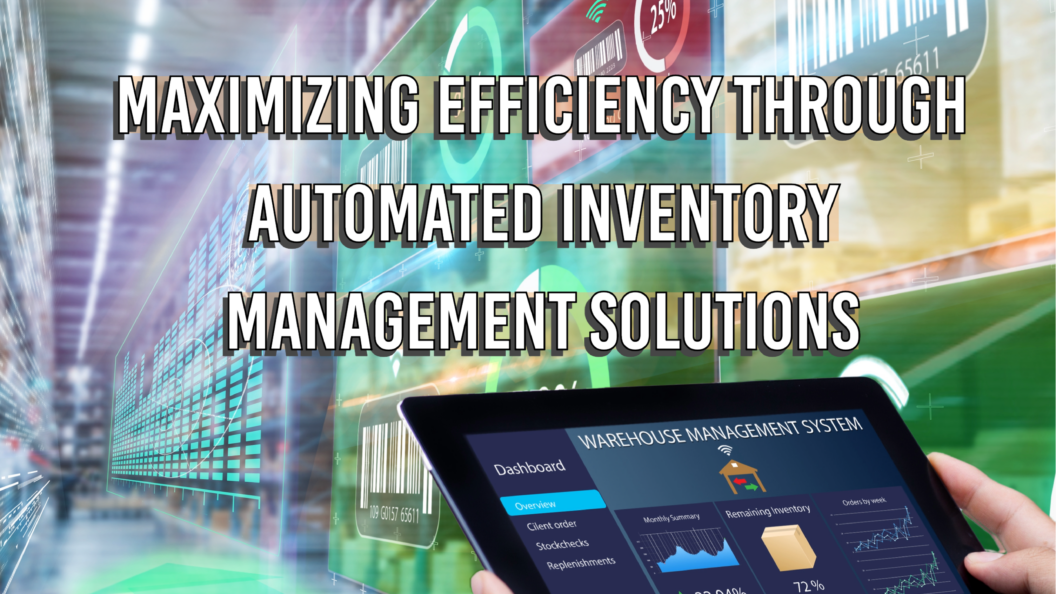Maximizing Efficiency Through Automated Inventory Management Solutions
Maximizing Efficiency Through Automated Inventory Management Solutions
Author: GDS
Automated inventory management solutions can help businesses streamline their operations by leveraging the latest technology. These solutions provide critical insights into a business’s supply chain and inventory so that executives and warehouse managers can accurately measure the impact of their decisions on the company’s bottom line.
In this article, we will discuss three essential inventory accounting metrics which are key to maximizing efficiency and gaining visibility into inventory operations: Inventory Aging, Inventory Turn, and Gross Margin by Item. We will also explore the various ways in which automated inventory management solutions can be used to reduce costs and optimize operations.
Automated inventory management solutions can help businesses streamline their operations by leveraging the latest technology. These solutions provide critical insights into a business’s supply chain and inventory so that executives and warehouse managers can accurately measure the impact of their decisions on the company’s bottom line.
In this article, we will discuss three essential inventory accounting metrics which are key to maximizing efficiency and gaining visibility into inventory operations: Inventory Aging, Inventory Turn, and Gross Margin by Item. We will also explore the various ways in which automated inventory management solutions can be used to reduce costs and optimize operations.
What is Inventory Accounting?
Inventory accounting is the process of measuring the impact of inventory on a company’s balance sheet. It is an important part of financial management and is used to track, record, and report changes in inventory levels. By tracking and analyzing inventory data, businesses can make informed decisions about how best to manage their inventories.
An effective inventory accounting system allows for accurate tracking of the cost of goods sold (COGS) and inventory values. It also provides a means for forecasting and planning future purchases, which helps to ensure that businesses have sufficient stock on hand when needed. In addition, an effective system can help to identify opportunities to reduce waste and optimize efficiency within the supply chain.
What is Inventory Accounting?
Inventory accounting is the process of measuring the impact of inventory on a company’s balance sheet. It is an important part of financial management and is used to track, record, and report changes in inventory levels. By tracking and analyzing inventory data, businesses can make informed decisions about how best to manage their inventories.
An effective inventory accounting system allows for accurate tracking of the cost of goods sold (COGS) and inventory values. It also provides a means for forecasting and planning future purchases, which helps to ensure that businesses have sufficient stock on hand when needed. In addition, an effective system can help to identify opportunities to reduce waste and optimize efficiency within the supply chain.
Inventory Aging
Inventory aging is an inventory accounting metric used to identify the length of time that stock has been held by a company. It can be used to determine the shelf life of products, and whether they should be sold or discarded. This information can help businesses improve their inventory management and increase efficiency in their operations.
To calculate inventory aging, you need to know the date when each item was first acquired and its current inventory value. Then, subtract the acquisition date from the current inventory value to get the age of each item in days. The average age of all items can then be calculated by adding up all individual ages and dividing by the total number of items.
Tracking inventory aging provides numerous benefits for businesses. It helps to identify slow-moving or obsolete items, allowing businesses to adjust their stock levels accordingly. In addition, it can help to optimize inventory flow and alert businesses when goods may need to be discounted or disposed of due to age. This helps them avoid holding too much inventory for too long, which can result in losses from spoilage or obsolescence. Furthermore, tracking this metric allows businesses to plan for future inventory needs, ensuring that they have the right amount of stock on hand when required. This helps to minimize delays in fulfillment and maximize the overall efficiency of operations.
Inventory Aging
Inventory aging is an inventory accounting metric used to identify the length of time that stock has been held by a company. It can be used to determine the shelf life of products, and whether they should be sold or discarded. This information can help businesses improve their inventory management and increase efficiency in their operations.
To calculate inventory aging, you need to know the date when each item was first acquired and its current inventory value. Then, subtract the acquisition date from the current inventory value to get the age of each item in days. The average age of all items can then be calculated by adding up all individual ages and dividing by the total number of items.
Tracking inventory aging provides numerous benefits for businesses. It helps to identify slow-moving or obsolete items, allowing businesses to adjust their stock levels accordingly. In addition, it can help to optimize inventory flow and alert businesses when goods may need to be discounted or disposed of due to age. This helps them avoid holding too much inventory for too long, which can result in losses from spoilage or obsolescence. Furthermore, tracking this metric allows businesses to plan for future inventory needs, ensuring that they have the right amount of stock on hand when required. This helps to minimize delays in fulfillment and maximize the overall efficiency of operations.
Inventory Turn
Inventory turn, or stock turnover, is a measure of how efficiently a company is managing its inventory levels. It shows the number of times that inventory has been sold or used over a given period. To calculate this metric, divide the value of goods used/sold for a certain period (usually a year) by the average value of inventory on hand. This figure is important for businesses to understand, as it helps to show how frequently stock is being sold and replaced.
Inventory Turn
Inventory turn, or stock turnover, is a measure of how efficiently a company is managing its inventory levels. It shows the number of times that inventory has been sold or used over a given period. To calculate this metric, divide the value of goods used/sold for a certain period (usually a year) by the average value of inventory on hand. This figure is important for businesses to understand, as it helps to show how frequently stock is being sold and replaced.
Benefits of Tracking this Metric
Having an effective inventory turn rate can be beneficial in many ways. Firstly, it helps to ensure that businesses have just enough inventory to meet customer needs without being overstocked. This helps to reduce expenses related to storage costs and the cost of holding inventory. Secondly, it can help businesses optimize their ordering and stocking processes, ensuring that they are getting deliveries when needed with minimal disruption to operations. Lastly, tracking this metric is an effective way to measure the performance of a business’s inventory management system. Regular monitoring allows businesses to identify areas of improvement, allowing them to maximize the effectiveness of their inventory management system.
- Improved accuracy: Automated inventory management systems allow businesses to accurately track and monitor their stock levels, helping to ensure that they are always stocked with the right amount of goods for customer needs.
- Increased efficiency: Automation reduces the need for manual data entry and calculations, allowing businesses to save time and money while optimizing their processes.
- Reduced costs: Automation can help reduce the cost of lost, damaged or expired goods due to inaccurate stock control and forecasting.
- Increased visibility: Automated systems provide a real-time view of inventory levels, allowing businesses to quickly adjust their operations to maximize efficiency.
Benefits of Tracking this Metric
Having an effective inventory turn rate can be beneficial in many ways. Firstly, it helps to ensure that businesses have just enough inventory to meet customer needs without being overstocked. This helps to reduce expenses related to storage costs and the cost of holding inventory. Secondly, it can help businesses optimize their ordering and stocking processes, ensuring that they are getting deliveries when needed with minimal disruption to operations. Lastly, tracking this metric is an effective way to measure the performance of a business’s inventory management system. Regular monitoring allows businesses to identify areas of improvement, allowing them to maximize the effectiveness of their inventory management system.
- Improved accuracy: Automated inventory management systems allow businesses to accurately track and monitor their stock levels, helping to ensure that they are always stocked with the right amount of goods for customer needs.
- Increased efficiency: Automation reduces the need for manual data entry and calculations, allowing businesses to save time and money while optimizing their processes.
- Reduced costs: Automation can help reduce the cost of lost, damaged or expired goods due to inaccurate stock control and forecasting.
- Increased visibility: Automated systems provide a real-time view of inventory levels, allowing businesses to quickly adjust their operations to maximize efficiency.
Gross Margin by Item
Gross margin by item is an important inventory accounting metric that helps to measure the profitability of each product and provide insight into its potential future benefits. It is calculated by subtracting the cost of acquiring, holding and selling goods from their total sales value. This provides businesses with a better understanding of which products are making money and which ones need improvement to see better results.
Benefits
- Improved Profitability: By understanding which products are performing well and which ones are not, businesses can make more informed decisions when it comes to allocating resources and optimizing pricing strategies.
- Increased Cash Flow: Knowing which products have the potential for higher gross margins allows businesses to allocate their resources more efficiently, maximizing their cash flow.
- Improved Decision-Making: With a better understanding of which products are performing well or not, businesses can adjust their inventory levels and pricing strategies accordingly. This can lead to increased profitability and improved performance overall.
By tracking gross margin by item, companies can gain valuable insight into the performance of their products, identify areas for improvement and make better decisions regarding their inventory levels and pricing strategies. Automated inventory management solutions can provide businesses with an up-to-date view of their product performance, allowing them to quickly adjust their operations and maximize efficiency. This can lead to improved revenue, increased profitability and enhanced customer service. With the right inventory accounting metrics in place, companies can take control of their operations and ensure they remain competitive in today’s ever-changing market.
Gross Margin by Item
Gross margin by item is an important inventory accounting metric that helps to measure the profitability of each product and provide insight into its potential future benefits. It is calculated by subtracting the cost of acquiring, holding and selling goods from their total sales value. This provides businesses with a better understanding of which products are making money and which ones need improvement to see better results.
Benefits
- Improved Profitability: By understanding which products are performing well and which ones are not, businesses can make more informed decisions when it comes to allocating resources and optimizing pricing strategies.
- Increased Cash Flow: Knowing which products have the potential for higher gross margins allows businesses to allocate their resources more efficiently, maximizing their cash flow.
- Improved Decision-Making: With a better understanding of which products are performing well or not, businesses can adjust their inventory levels and pricing strategies accordingly. This can lead to increased profitability and improved performance overall.
By tracking gross margin by item, companies can gain valuable insight into the performance of their products, identify areas for improvement and make better decisions regarding their inventory levels and pricing strategies. Automated inventory management solutions can provide businesses with an up-to-date view of their product performance, allowing them to quickly adjust their operations and maximize efficiency. This can lead to improved revenue, increased profitability and enhanced customer service. With the right inventory accounting metrics in place, companies can take control of their operations and ensure they remain competitive in today’s ever-changing market.
Leveraging Automated Inventory Management Solutions to Reduce Costs and Optimize Operations
By leveraging automated inventory management solutions, businesses can reduce costs associated with manual processes and optimize their operations. Automation allows companies to streamline their operations by quickly accessing accurate and up-to-date information about their products, eliminating the need for manual data entry. This can help reduce the time and money spent on labor-intensive processes like inventory counting and billing.
Automated inventory management solutions can also provide companies with detailed insights into their operations, allowing them to make better decisions about their inventory levels and pricing strategies. With automated systems in place, businesses can quickly track gross margin by item and identify areas for improvement while minimizing the risk of human error. This can lead to improved revenue, increased profitability and enhanced customer service.
Leveraging Automated Inventory Management Solutions to Reduce Costs and Optimize Operations
By leveraging automated inventory management solutions, businesses can reduce costs associated with manual processes and optimize their operations. Automation allows companies to streamline their operations by quickly accessing accurate and up-to-date information about their products, eliminating the need for manual data entry. This can help reduce the time and money spent on labor-intensive processes like inventory counting and billing.
Automated inventory management solutions can also provide companies with detailed insights into their operations, allowing them to make better decisions about their inventory levels and pricing strategies. With automated systems in place, businesses can quickly track gross margin by item and identify areas for improvement while minimizing the risk of human error. This can lead to improved revenue, increased profitability and enhanced customer service.
Conclusion
Automated inventory management solutions can provide businesses with the insights needed to optimize their operations and improve their bottom line. By leveraging these solutions, companies can access accurate and up-to-date information about their products which can lead to improved revenue, increased profitability and enhanced customer service. With the right inventory accounting metrics in place, companies can take control of their inventory and maximize efficiency in today’s ever-changing market.
Conclusion
In conclusion, automated inventory management solutions can provide businesses with the insights needed to optimize their operations and improve their bottom line. By leveraging these solutions, companies can access accurate and up-to-date information about their products which can lead to improved revenue, increased profitability and enhanced customer service. With the right inventory accounting metrics in place, companies can take control of their inventory and maximize efficiency in today’s ever-changing market.
GDS ONSIGHT- A Field Service & Delivery Application
If you’re looking for an automated inventory management solution that can help maximize efficiency, contact us today and see how our team of experts can help. We would love to answer any questions or provide more information about our services. With the right tools in place, your business can take control of its inventory and succeed in today’s market. Don’t wait – contact us today to get started!
GDS ONSIGHT- A Field Service & Delivery Application
If you’re looking for an automated inventory management solution that can help maximize efficiency, contact us today and see how our team of experts can help. We would love to answer any questions or provide more information about our services. With the right tools in place, your business can take control of its inventory and succeed in today’s market. Don’t wait – contact us today to get started!








